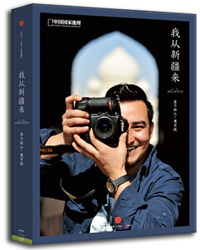 |
|
THROUGH HIS LENS: The cover of the book I Am From Xinjiang features a photo of its author Kurbanjan Samat (COURTESY OF KURBANJAN SAMAT) |
A widespread stereotype in China holds that migrant workers from the country's northwestern Xinjiang Uygur Autonomous Region are people who work in coastal cities as street vendors of kebabs or nuts. However, photographer Kurbanjan Samat's new book, I Am From Xinjiang, proves that people from the region are hardly limited to these typecast roles. Xinjiang natives work as doctors, reporters, teachers, company employees and more all across the country.
"I have stayed in Beijing longer than in Xinjiang," said Aniwar Mamat, a 52-year-old ethnic Uygur and native of the far western region. Aniwar, who first came to Beijing in 1983, was among the first group of Xinjiang businessmen to arrive in the capital city after the launch of China's reform and opening up in the late 1970s. Before moving east, Aniwar ran a restaurant near the Urumqi Train Station.
"I came here because I wanted to live a better life," Aniwar said.
Aniwar sold fruits and roast mutton kebabs before buying a traditional Beijing quadrangle courtyard and converting it into a Xinjiang-style restaurant in 2004. The restaurant, which was built to resemble a small mosque on the outside, is well-known among almost all Xinjiang transplants in Beijing.
The author Kurbanjan, who got to know Aniwar through his restaurant, featured the latter as one of the character sketches in his book. Published by China Citic Press, the book was released on October 16 and includes the author's photographs of 100 native Xinjiangers from a number of different ethnic groups, working and living in cities across the Chinese mainland. Next to each photo is a narrative of the subject's life, as told by each interviewee to Kurbanjan.
Craving greater understanding
Talking about his intentions behind publishing the book, Kurbanjan said that he wanted people from other parts of China to achieve a better understanding of Xinjiangers. In recent years, Xinjiang secessionists have committed a series of violent attacks in the region and elsewhere in China, and as an unfortunate result of this, Xinjiang residents are often looked upon with suspicion. Kurbanjan has encountered this sort of misunderstanding—and even discrimination—many times. He was once refused a room at a hotel because of his identity as an ethnic Uygur.
Kurbanjan said that he wants to tell people that violence may occur not only in Xinjiang but in many other places in China and throughout the rest of the world and that one small group of Xinjiangers' wrongdoing cannot prove that all people from there are oriented toward violence.
"People from Xinjiang are no different than people from Sichuan or Shandong. It's unfair to stereotype us as terrorists or kebab vendors," he added.
Kurbanjan initially wanted to make a TV documentary featuring Xinjiang people's stories two years ago. Insufficient funding meant the plan was never to come to fruition. Then on March 1, five knife-wielding terrorists from Xinjiang killed 31 people and injured 141 others at the Kunming Railway Station in Yunnan Province. Kurbanjan felt miserable: On the one hand, he was deeply saddened by the loss of innocent lives, but on the other, he knew that the misunderstandings and stereotypes of Xinjiangers would be etched even deeper into people's memories by the event.
He couldn't wait any longer. He immediately took photos of 30 Xinjiang natives that he knew and published them, along with each subject's story, on the Internet. The photos received wide attention from netizens, with many starting to look at Xinjiangers in a more objective and rational manner.
Seeing these photos, some natives of the region working and living elsewhere commented with tales of their own occupations and adopted cities. Following such an outpouring of support, Kurbanjan was able to track down and interview more people for his project. During the four months following the attack, Kurbanjan visited over 20 cities and photographed and interviewed more than 500 Xinjiang natives—not only Uygurs, but also Hans, Kazaks, Huis and Mongolians. He selected the stories of the 100 who moved him most and compiled their photos and narratives into a book. All the expenses for publishing it have come from his own savings.
"I wanted to provide an effective channel of communication between Xinjiangers and people from other parts of China through the book," Kurbanjan told Beijing Review.
| 